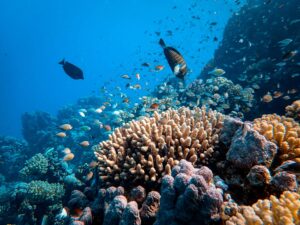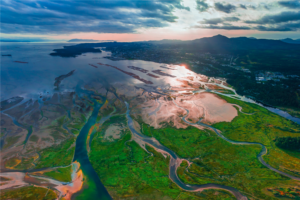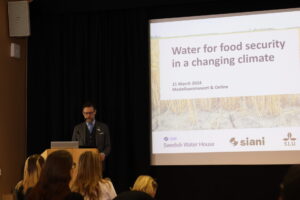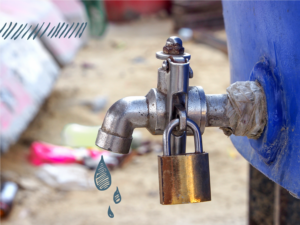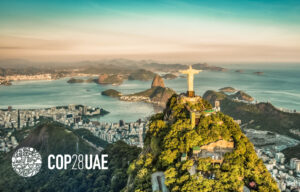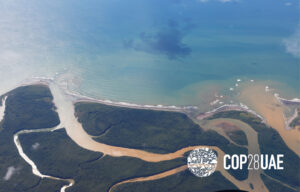- SIWI – Leading expert in water governance
- /
- Latest
- /
- A healthier world through water
A healthier world through water
 Stephanie Wear from The Nature Conservancy
Stephanie Wear from The Nature Conservancy World Health Day this year focuses on building a fairer, healthier world. Why is it important to consider source-to-sea linkages when assessing the downstream impacts of untreated wastewater and promoting appropriate water, sanitation, and hygiene (WASH)? We spoke to Stephanie Wear from The Nature Conservancy about how a source-to-sea approach and sharing knowledge can help us build a healthier more resilient world.
Untreated and even treated wastewater can have considerable downstream impacts far beyond the ocean, with serious implications for climate change resilience, economic stability, food security, social equity, and water accessibility. Aside from providing food and livelihoods, estuarine environments serve as productive habitats that offer various ecosystem services including carbon sequestration, erosion control, and water filtration. Salt marshes, mangroves, and wetlands have traditionally been considered natural filtration systems that can treat sewage, but recent research has shown otherwise. When exposed to frequent sewage pollution, estuarine habitats can experience critical degradation in structure and function, rendering them extremely vulnerable to environmental stressors like climate change. This is a huge point of concern, since already more than 30% of salt marshes worldwide are heavily polluted from sewage contamination. We cannot risk losing these critical ecosystems when coastal populations, like those in Small Island Developing States, depend on their health and productivity.
How do we start to address this problem?
We can solve the environmental and ecological consequences of sewage pollution through improved sanitation and wastewater treatment. Additionally, by addressing the global sanitation crisis and providing safe sanitation, we can prevent over 1.5 million annual deaths from diarrheal diseases. We can empower marginalized communities and women who do not have access to proper, safe facilities. By managing social and health concerns, we can encourage an untapped workforce and spur on economic growth.
There is also much work to be done in developed countries, where wastewater treatment infrastructure is outdated, and pipes and treatment plants are at the end of their lifespans. For example, in the United States alone, 1.2 trillion gallons of wastewater and storm water are discharged annually untreated due to storm overflows and other system failures. Greater governmental oversight and updated policymaking could improve conditions, but we should also encourage and incentivize innovation in treatment technologies. We need to rethink waste management as a circular economy. We have an opportunity to perceive sewage as a resource, rather than waste.
How can the source-to-sea approach help?
The source-to-sea approach is vital to address these issues because we have realized this problem is complex and requires expertise in conservation, policy, public health, civil society, utilities, and water, sanitation, and hygiene (WASH). It is critical that we involve stakeholders and practitioners from all scales across all sectors. We aim to work with stakeholders from both upstream and downstream – we value the voices of local community representatives as much as the opinions of corporate entities invested in water quality. By breaking down information silos and aggregating a collective Knowledge Hub, we can take an integrative approach where we treat the sewage pollution problem, rather than displace it.
The Nature Conservancy recently joined the Action Platform of Source-to-Sea Management. What motivated your organization to join the platform and what are some of the main benefits you envision?
We realize this problem cannot be addressed by one organization, so we recognize the value of the S2S approach and being a partner of the Platform. As much as we can bring to the table from a conservation standpoint, we still strive to learn from others, exchange experiences, and contribute to the dialogue. Having transparency and accessibility of information is key to removing redundancy in work and creating a solution space. We hope to share our insights and generate greater interest in sewage pollution and its impacts across the source-to-sea continuum , so that research efforts and initiatives are continued and expanded upon.
The Action Platform on Source to Sea Management recently published its 2021-2025 Strategy, how can The Nature Conservancy contribute to achieving its goals?
As a science-based organization, TNC can build the evidence base on source-to-sea approaches and make the case for proper wastewater treatment to improve both downstream ecosystem health and human health. Our Long Island Sound program already demonstrates the importance of a holistic approach to economic development and natural resources management, and we hope to implement similar projects that take the source-to-sea approach. We also are developing the Ocean Sewage Alliance (OSA), a network of diverse stakeholders who are taking a cross-sector, collaborative approach to share knowledge and develop solutions to the sewage pollution problem and its downstream impacts. The OSA will serve as a conduit for information exchange and connect invested organizations with the S2S Platform.


